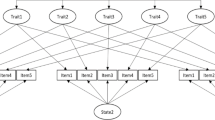Abstract
A mathematical model is applied to happiness and mood data from a successful group therapy intervention with elderly nursing home residents (Rattenbury and Stones, 1989). The model permits estimations of acute environmental change within and across therapy sessions, and the comparison of such estimates with the changes in happiness from before to after the total intervention. The findings show intervention success (i.e., the change in happiness) to correlate with across session changes, and particularly those in the basal (presession) acute environment, but with no correlation between therapeutic success and within session changes. These findings suggest a positive facilitation to the chronic environment during the progression of therapy.
Similar content being viewed by others
References
Atkinson, T.: 1982, ‘The stability and validity of quality of life measures’, Social Indicators Research 10, pp. 113–132.
Bradburn, N. M.: 1969, The Structure of Psychological Well-Being (Aldine, Chicago).
Costa, P. T. and R. R. McCrae: 1984, ‘Personality as a lifelong determinant of well-being’, in C. Z. Malatesta and C. E. Izard (eds.), Emotion in Adult Development (Sage, CA).
Costa, P. T., R. R. McRae, and A. B. Zonderman: 1987, ‘Environmental and dispositional influences on well-being: Longitudinal follow-up of an American national sample’, British Journal of Psychology 78, pp. 299–306.
Diener, E.: 1984, ‘Subjective well-being’, Psychological Bulletin 95, pp. 542–575.
Fox, C. R. and D. Kahneman: 1992, ‘Correlation, causes and heuristics in surveys of life satisfaction’, Social Indicators Research 27, pp. 221–234.
Kozma, A., R. di Fazio, M. J. Stones, and T. E. Hannah: 1992, ‘Long- and short-term affective states in happiness: Age and sex comparisons’, Social Indicators Research 4, pp. 293–310.
Kozma, A., M. J. Stones, and K. McNeil: 1991, Subjective Well-Being in Later Life (Butterworths, Toronto).
Kozma, A., S. Stone, M. J. Stones, T. E. Hannah, and J. K. McNeil: 1990, ‘Long- and short-term affective states in happiness’, Social Indicators Research 22, pp. 119–138.
May, R. M.: 1976, ‘Simple mathematical models with very complicated dynamics’, Nature 261, pp. 459–467.
McNeil, K., M. J. Stones, and A. Kozma: 1986, ‘Subjective well-being in later life: Issues concerning measurement and prediction’, Social Indicators Research 18, pp. 35–70.
McNeil, J. K., M. J. Stones, A. Kozma, and D. Andres: in press, ‘Age differences in mood: Structure, mean level, and diurnal variation’, Canadian Journal on Aging.
Michalos, A.: 1985, ‘Multiple discrepancies theory’, Social Indicators Research 8, pp. 358–442.
Parvot, W. and E. Diener: 1993, ‘The affective and cognitive context of self-reported measures of subjective well-being’, Social Indicators Research 28, pp. 1–20.
Rattenbury, C. and M. J. Stones: 1989, ‘A controlled evaluation of reminiscence and current-topics discussion groups in a nursing home context’, The Gerontologist 29, pp. 768–771.
Stewart, I.: 1989, Does God Play Dice? The Mathematics of Chaos (Basil Blackwell, Oxford).
Stones, M. J., B. Dornan, and A. Kozma: 1989, ‘The prediction of mortality in elderly institution residents’, Journal of Gerontology 44, pp. 72–79.
Stones, M. J. and A. Kozma: 1980, ‘Issues relating to the usage and conceptualization of mental health constructs employed by gerontologists’, International Journal of Aging and Human Development 11, pp. 269–281.
Stones, M. J. and A. Kozma: 1986, ‘“Happy are they who are happy ...”: A test between two causal models of relationships between happiness and its correlates’, Experimental Aging Research 12, pp. 23–29.
Stones, M. J. and A. Kozma: 1989a, ‘Happiness and activities in later life: A propensity formulation’, Canadian Psychology 30, pp. 526–537.
Stones, M. J. and A. Kozma: 1989b, ‘Multidimensional assessment of the elderly via a microcomputer: The SENOTS program and battey’, Psychology and Aging 4, pp. 113–118.
Stones, M. J. and A. Kozma: 1991, ‘A magical model of happiness’, Social Indicators Research 25, pp. 31–50.
Stones, M. J. and A. Kozma: 1992, ‘A magical model to predict individual differences in mood change’, Social Indicators Research 27, pp. 103–111.
Stones, M. J. and A. Kozma: in press, ‘The relationship of affect intensity to happiness’, Social Indicators Research.
Author information
Authors and Affiliations
Rights and permissions
About this article
Cite this article
Stones, M.J., Rattenbury, C. & Kozma, A. Application of a nonlinear mathematical model to data on a successful theraputic intervention. Soc Indic Res 31, 47–61 (1994). https://doi.org/10.1007/BF01086513
Accepted:
Issue Date:
DOI: https://doi.org/10.1007/BF01086513




